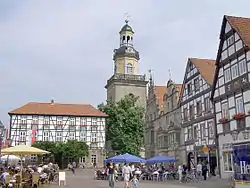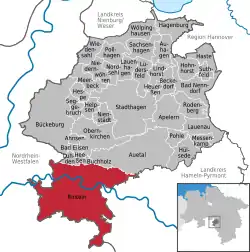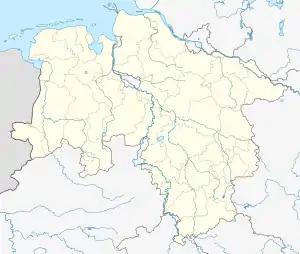Rinteln
Rinteln (German: [ˈʁɪntl̩n] (![]() listen)) is a small town in Lower Saxony, Germany. It is located on the banks of the Weser river above the Porta Westfalica. The town of Rinteln is in the broad valley between the hills of the Weserbergland and the North Lippe Bergland. In relation to some well known places, it is 60 kilometers west of Hanover, and just 20 kilometers from Hamelin of Pied Piper fame.[2] Its population is about 28,500.
listen)) is a small town in Lower Saxony, Germany. It is located on the banks of the Weser river above the Porta Westfalica. The town of Rinteln is in the broad valley between the hills of the Weserbergland and the North Lippe Bergland. In relation to some well known places, it is 60 kilometers west of Hanover, and just 20 kilometers from Hamelin of Pied Piper fame.[2] Its population is about 28,500.
Rinteln | |
|---|---|
 | |
 Coat of arms | |
Location of Rinteln within Schaumburg district  | |
 Rinteln  Rinteln | |
| Coordinates: 52°11′26″N 9°4′53″E | |
| Country | Germany |
| State | Lower Saxony |
| District | Schaumburg |
| Subdivisions | 10 Stadtteile |
| Government | |
| • Mayor | Thomas Priemer (SPD) |
| Area | |
| • Total | 109 km2 (42 sq mi) |
| Elevation | 56 m (184 ft) |
| Population (2019-12-31)[1] | |
| • Total | 25,424 |
| • Density | 230/km2 (600/sq mi) |
| Time zone | UTC+01:00 (CET) |
| • Summer (DST) | UTC+02:00 (CEST) |
| Postal codes | 31737 |
| Dialling codes | 05751 |
| Vehicle registration | SHG, RI |
| Website | www.rinteln.de |

History
The settlement of Rinteln was founded about 1150 on the northern bank of the Weser. Later, in 1235, the village of Neu-Rinteln ("New Rinteln") was founded on the southern bank. It is the origin of the modern town, since the northern village was abandoned in 1350 due to the plague. The village grew to a fortified town, that served as a southern stronghold of the Counts of Schaumburg.
From 1621 until its dissolution in 1810 during the Westphalian rule under Jérôme Bonaparte, Rinteln was the seat of Ernestina University. When the County of Schaumburg was divided in 1640, Rinteln became the capital of the eastern part, that retained the name Grafschaft Schaumburg hessischen Anteils. The Eulenburg in Rinteln became the seat of the counts. Rinteln remained the capital of the county and later of the district, until it was merged with the neighboring district of Schaumburg-Lippe in 1977.
In 1875, the railway station was opened.[3]
Villages
- Ahe
- Deckbergen
- Engern
- Exten
- Friedrichshöhe
- Friedrichswald
- Goldbeck
- Hohenrode
- Kohlenstädt
- Krankenhagen
- Möllenbeck
- Rinteln
- Schaumburg
- Steinbergen
- Strücken
- Todenmann
- Uchtdorf
- Volksen
- Wennenkamp
- Westendorf
References
- Landesamt für Statistik Niedersachsen, LSN-Online Regionaldatenbank, Tabelle 12411: Fortschreibung des Bevölkerungsstandes, Stand 31. Dezember 2019.
- http://www.orpheusweb.co.uk/lakes/kendal/Rin.html
- "Rinteln - A Short History" (PDF). Kendal-Rinteln Association. Retrieved 2016-03-06.
- http://www.rinteln.de/partnerstaedte/